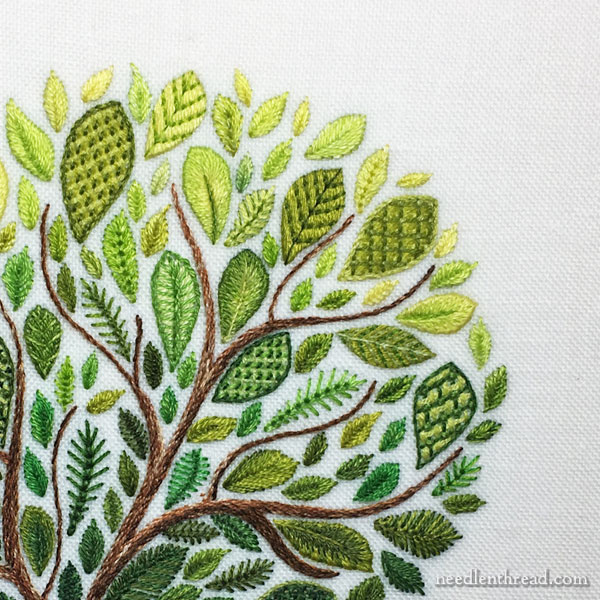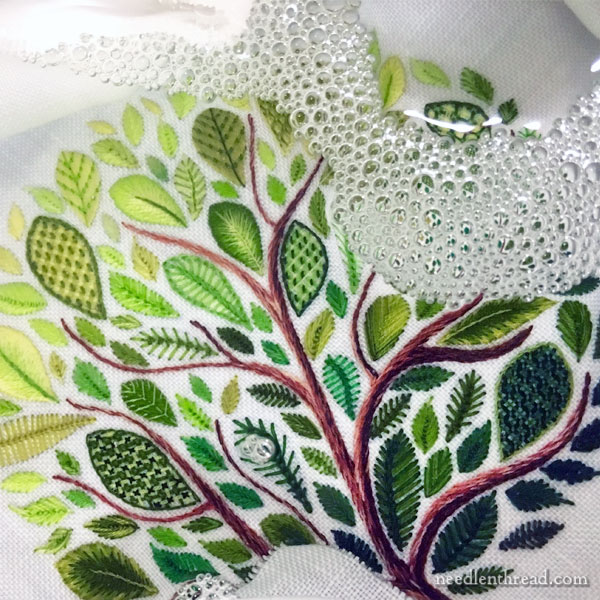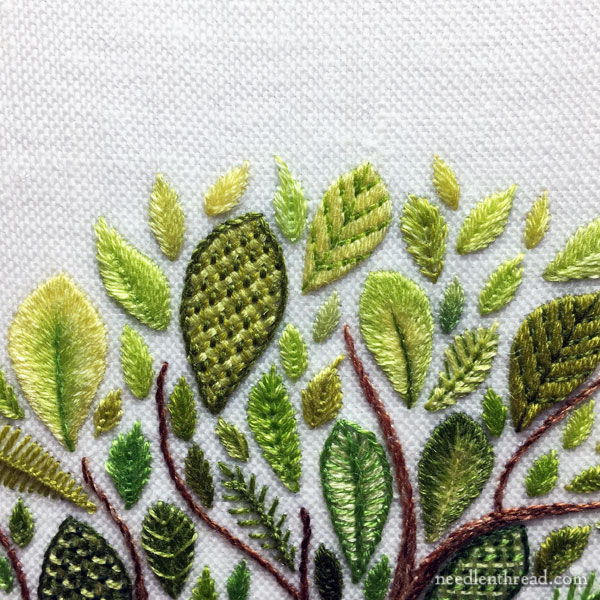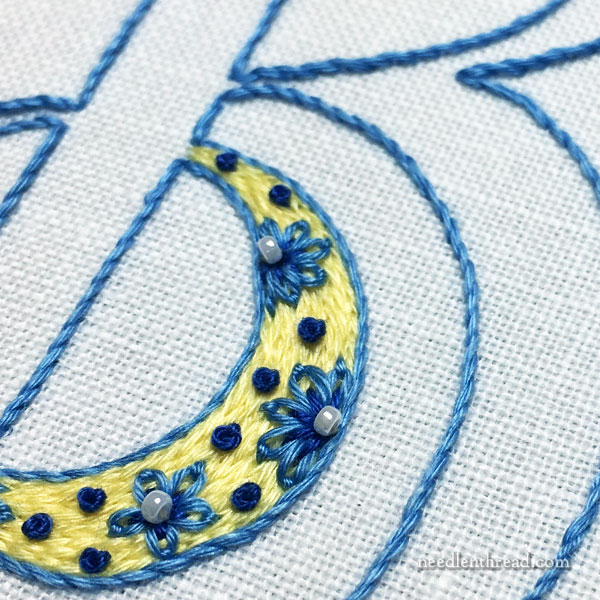Happy Monday! (It does come around quickly, doesn’t it?!)
I finished embroidering this leafy tree sampler project that I was working on.
I’ll be sharing the whole project with you down the road. I have a few tweaks to make on it and I want to stitch it one more time, with a different approach.
Normally, it’s a good thing when a project is finished, right? But when I finished this one, I found myself at that in-between stage – in a state of suspension.
I’ll tell you about that and what I did to get out of it. And I’ll share some portions of that leafy tree sampler and explain the steps I take after finishing a project like this.

I loved working on this project! The embroidery was fun! With lots of different stitches and many shades of green to mix up, it provided variety the whole time – never a chance to get bored stitching the same thing or the same technique over and over again.
And because of the nature of my design, I found it was a perfect project for stitching in stages.
Whether I was “binge stitching” for several hours, or I just had a few minutes to eke in some stitches, this project worked well either way. No matter how short or how long the stitching session, progress is always obvious and there’s always a little accomplishment, even if it’s just one little leaf!
Incidentally, in the photo above, the finished project is soaking wet.

When I finish a project that’s worked on linen or cotton with threads that I’m confident won’t run (so, DMC cottons, wools, certain silks – but not hand-dyed, overdyed threads), I give it a bath in cool to lukewarm water, sometimes with a little liquid ivory in it.
In this case, I soaked the piece overnight, because my drawn lines hadn’t quite disappeared after a half hour or so in the bowl.
The next morning, the lines had disappeared enough, so I removed the embroidery from the bowl it was soaking in, rinsed it well under cool water, and laid it between two clean, thick bath towels. Using my hands, I pressed out the excess water.
Then, I blocked it on a cork board. I’ve explained how to damp stretch and block a piece of embroidery in this tutorial.
If you want a really nice finish on your embroidery – wrinkle free, with any puckers that have developed completely minimized if not gone altogether – then you should stretch and block your needlework.
You can do this after you’ve soaked it (if it’s soakable) like I did with this piece, or if it’s not completely soakable, you can pin it on the board as shown in the tutorial and lightly mist it with water. This will relax the fibers and stretch the fabric and remove the wrinkles.

There it is again, very wet, but pinned and ready to dry. I usually leave it at least overnight, but usually 24 hours on the board.
The In-Between
I often experience what I call the End-of-Project Blues, especially when I’ve been stitching on a project I really enjoyed.
Lately, I haven’t had time to fall into that Blue Funk, though, because I have a list of projects I want to get through this year. I’ve tried to organize them chronologically, so that I move from one to the other in a clear progression. Most of the projects will end up either on Needle ‘n Thread as a download for you, or they will be projects that I blog about, so that you can follow along with them or just pick up stitching tips.
Still, despite the chronological order, I’m not always ready to jump into the next project. Maybe I’m waiting on some supplies, maybe I don’t have the larger chunk of time to tackle the set-up, maybe the next project just isn’t speaking to me.

I do not like that state of suspension, where I’m not quite ready to move into The Next Big Project, and I don’t have anything to work on.
So that’s when I fall back on little projects – my in-between projects – like this developing monogram in the photo above.
I’ve had this particular style of lettering in mind for a while, and I’ve got some ideas on how I want to develop the lettering into some blue, yellow, and white monograms. It’s one of my favorite color combinations, and this style allows for many possible interpretations.
This little project will give me something to stitch and a little challenge to work through, especially during this week and next, which is always a very busy time for my family.
While I’m stitching on this, some magical things will happen! I’ll solidify my ideas for The Next Big Project (because it will be constantly brewing in my head), I’ll work ahead on the website so that I free up more time to tackle The Next Big Project, and at the same time, I’ll be developing another little project that I can eventually share with you, too.
So it all works out!
What About You?
Did you manage to get in any stitching time this last weekend? What are you working on? I’d love to hear about your current projects!
If you’ve run into any snags or anything that is holding you up, have you identified the problem and tackled it? Do you have any questions or need any help? You’d be surprised how many folks reading along here on Needle ‘n Thread would love to chime in and help you on your stitching journey! Feel free to chat with us about your current project – and any triumphs or troubles – below!
Goings On
Today’s the last day of my spring sale in my online shop, where you can find all my project, instructional, and pattern e-books marked 15% off right now. If you’re hankering, it’s a good time to pick up your favorites!
Over in the Needle ‘n Thread Community group on Facebook, some of the participants are getting up a stitch-along for the Lattice Jumble Sampler. I’m not coordinating the thing, but I’ll be around to answer questions and so forth, and so will the rest of a very supportive community. If you have the Lattice Jumble e-book and you’re on Facebook and want to join in, hop on over to the group! Joining up is simple – just click the join button and answer the three questions there.
Hope your week’s off to a swell start!







I have been working on a very detailed cross stitch of an anatomical heart but I set that aside for awhile to do a crewel project. Then I randomly over the weekend started a blackwork biscornu! Except it’s silver/white floss on black aida, which is as awful to work as it sounds! It looks so nice though that I keep going. I might add some Kreinik silver and some tiny beads, but we’ll see. If I feel like I need to “get done” with a project I’ll never finish it and I like switching to different materials and techniques here and there. Keeps it all fresh. After working with Appleton’s, DMC floss feels like a strand of silk!
LOL!! Isn’t that the truth! It’s always an adjustment, going from wool back to cotton floss (or visa-versa)!!
Working on dark fabrics is very challenging. You definitely need a good light, but one of the best tricks I have found is to put a white or very light colored fabric in your lap. This will help to reflect light up from the bottom and you can see the holes better. It was originally suggested to be to put a light under the work, but I found that to be too bright. The cloth works so much better.
Hi Mary,
I also think I get the Stitching Blues between projects! I am glad to hear I am not alone. I am working on PinTangle’s TAST and last week we had a break for people to catch up.
I spent it working on my very first design (Mabel the Raccoon: https://www.thecrafties.com/2018/03/mabel-the-raccoon/) and am super proud of it! Though I don’t know what to do with it next. I could certainly use some ideas – I don’t want to just leave her in a hoop as I think that is becoming overdone. I’ve considered wrapping her around a block or rod of wood but I don’t really know anything about that. Just thought it might be fun to do a whole series of animals like that, that a child could play with maybe.
I love how your leaves turned out, and thanks for the damp stretching tutorial. I’ve been using it ever since I first read about it and it helped put the confidence back in my work! I am excited to see some more monograms, too!!
-C
Mabel is super cute!
Wonderful post, Mary, and I followed the link to your tutorial to see how you blocked your piece. No wonder I have had such disappointing results in the past! I was wondering about the stitching around the outside edge of the sample piece on that tutorial…do you always do a stay stitching or ? And maybe you have addressed that on the blog before too…pretty new here. Seems like my last embroidery project I had masking tape around the outside cut edges to keep from ravelling, and maybe that would not be sufficient to block. Thanks so much, Linda B
Hi, Linda – I usually “neaten” the edge of the fabric, just to keep stray fabric threads from going too far astray. I’ve written about it here: https://needlenthread.wpengine.com/2013/01/embroidery-tip-neatening-fabric-edge.html
Dear Mary
Your tree is absolutely beautiful I love all the different colour of the green threads and the different stitches you used really make it stand out. The monogram looks lovely I hope you show it to us. I’m still working on the quiet book but now I am actually putting the book together and sewing on all the activities so I can see it come alive. The difficult bits were cutting out the felt for various activities which were quite fiddly and took a long time to accomplish. Thanks for sharing your finished and future projects with us and for the photos.
Regards Anita Simmance
Hi Mary!
I worked on Rosalie Wakefield’s sweet little “Angelique” BE Tulip pattern over the weekend. It calls for some long and short satin stitching, which I couldn’t seem to get right (not pleasing at all), so I used an outline stitch and tried to be chaotic about it. Maybe it’s the rayon threads that don’t want to lay flat (especially the tighter twists), as I don’t seem to have that much problem with cotton floss satin stitching.
I used the Up and Down Buttonhole Stitch as you demonstrated in one of your monogram tutorials for the oval surrounding the Tulips. I had to draw a second oval so the stitches would be consistent.
I’ve been using a Frixxion pen to put the patterns on the fabric and just love that the lines disappear with heat from the iron – it gives me a lot of freedom to mark lines and directions directly on the pattern.
Oh Mary, this little tree is such a delight to see. Everything about it is wonderful and it’s full of so many ideas.
I’m working on a major project for TAST here and have already pulled out the center of one of the paisley’s. A couched grid just was not working with a buttonhole edge ~ they were from different styles of embroidery. Then too, the flowers that were worked up the center of the ‘swish’ while a good idea they weren’t cohesive. So out they came and I’ve drawn up a new progression for them complete with colors, stitches and thread count.
I’m really excited about this pieces’ progression and am thinking up ideas to use the rest of the stitches presented so far.
Thank you too for the piece about the tulip needles, they have now hit my wish list.
You are such a great addition to the needlework blogging world, your place is the first I go to for information about Anything in this craft.
Have a great stitching day ~ Brenda
I can’t wait to see how this monogram develops! It already looks great. I love the blue & white & yellow color combination too!
Me too! It’s beautiful!
Oh my God, is the letter beautiful!!! It’s such an awesome colour combination, I love the blues together with this vanilla yellow! Must definitely remember this combination, it’s so great. And this again combined with the flowers and the beads – just mind-boggling!
Oh, I stitch all the time, every day. When I’m not translating (my job) or being with a friend or my family, you’ll always find me stitching. 🙂 I’ve worked out a curriculum of sorts for my “embroidery apprenticeship” (of course, I’m teacher and student in personal union^^) that is enough to keep myself occupied for at least two years. *lol* So this suspence you’re talking about isn’t really an issue for me. Not yet, at least.
My current project I’m working on is a cross stitch sampler by Thérèse de Dillmont. And I’m surprised myself to admit – I like cross stitch! Of course it’s not that creative and rich in variety as surface embroidery, but it’s calming in a peculiar way… no thinking, just counting… and it always looks neat – as long as you meet the right hole. 😀
Angela from the Ore Mountains
“Suspence” – ouch! Had to be “suspense”, of course.
Will you be offering the tree as a pattern or Ebook? It is lovely!
Yes, eventually! Hopefully sooner rather than later!
I am working on a Nicola Jarvis piece. It is a beautiful design. My problem is when working with yarns, although Appleton is a good one, the fuzzies are hard to control. I have tried, covering parts with plastic wrap, using small brushes, the largest needle at hand, shorter lengths of the yarn so I am not pulling it through more than maybe 5-7 times and using tape to “stick it to” those nasty fuzzies. This work is on heavy cotton,which is lovely, but it takes a toll on the yarn. I guess the only way to cope with this is get the project done and do your best to “clean” it up.
Hi, Pat – can you try using a larger needle than you normally would? This might open the holes up a little larger for the thread to pass through without as much friction.
I really LOVE that tree, Mary! I’ve always had a ‘thing’ about leaves, & even planned to do a tree very like this one someday. Isn’t it strange how those ‘somedays’ never — or very seldom — get to happen? This is one of my all-time favourite pieces of yours.
You HAVE been stitching up a storm lately, haven’t you? New embroideries just seem to FLOW from your needle!
It’s been stunning to watch.
And now, in Holy Week, you will be run off your feet with family activities!
Hope you find some spare time to get in some stitching, & to catch up with your mail. Salut! R
Hi, Ros – yes, I have been! Bit of a slog through the weekend, with electricity out and all kinds of other stuff going on. Just got my computer and my network back to talking to each other this morning, so it’s a lot of computer work for the next couple days. Holy Week is always pretty busy – especially Thursday and Friday!
Mary…Last night, I did finish the little quilt with the Trish Burr Cardinal in the center and crazy quilting around frames of white. I know my Mom will enjoy it for Mother’s Day. And, while I am very happy to have completed the project, yes, I do have the “end of project” blues! I have a few ideas for the next project, but I can’t decide which should be next! Hopefully in a few days I will be back on track! I am looking forward to adding this “leaf” project to my list…soon, I hope!
Regards, Bonnie
I’ve been slowly working on a needlepainted butterfly, but I wasn’t really getting into it. I started it a month ago and only stitched about half of each of the bottom wings. I kept setting it aside, picking it back up, setting it down again. I decided it was the colors that are not working for me. I had originally planned to do it in blues/purples, but somehow I started it in pinks instead. I just ripped out a good portion of what I had stitched (work got in the way so I couldn’t finish ripping it out this morning) and I’ll be starting it over in the colors I originally wanted to do.
This weekend I worked on a needlepainted rose as a gift to a friend. This is also in pinks/burgundy but I’m loving it!
Isn’t it funny how the color can make such a HUGE difference on a project?
Ooo, Mary, I LOVE blue, yellow and white together! Saw the teaser pic and my heart leapt! Have a wonderful Easter!
I had been taught to make sure the drawing lines were always completely covered – I draw very fine lines if it is an original piece where there are lines that are not part of a filled area – and always do so. I have done some pieces that were original with minimal drawing.
I did an embroidered “platter” for a “Table Top” exhibition some time ago and with the exception of drawing some circles smaller than the flowers would be and the location of the gold line around the center of the piece, all the rest of the stitching was marked with straight pins – 3 rows around the outside edge for example to follow where to put the feather stitches for the vines which later had French knots added to them for flowers. I worked back and forth between the 3 rows of pins. I then added French knots to the ends for the flowers.
I have about 3 hours set aside on Thursday nights as my stitching time and managed to finish up one of two wings to be attached to a raised work butterfly from an EGA National Petite Project started over a decade ago, which I pulled out as my next piece to actually finish. Husband has started hunting for frames for it already – so I HAVE to finish it.
Hi Mary – lovely stitching. Curious what you used to transfer pattern to fabric that washes out?
Thank you!
I like your tree project. The part I actually like best is the branching of the tree limbs. They are very graceful looking to me and I also love the way you did the shading. I find myself tracing the pathways from the trunk up through all the limbs.
I’m having a wonderful time stitching up the kit projects – first I did the Lorikeet, now I’m working on the Zinnias – from your Inspirations giveaway at Christmas 🙂 I love the variety of stitches in the leaves on your tree, but I absolutely adore the sneak peek of your new monogram! The colour combination is beautiful – that buttercream yellow and the blues – but the little lazy daisy flowers and the French Knot polka dots are delightful!!!
Mary, despite your confidence in DMC floss being colorfast, I’d recommend testing darker colors before wet finishing. Especially red, of course. I recently did a project that fortunately won’t need to be washed which included a bit of very saturated red. The red even crocked a bit when I stitched, so I moistened some of the floss and laid it on a piece of fabric, and of course it bled.
Mary;
In regards to your washing the embroidery or only lightly mist it with water. I have read but not yet tried something I saw on-line recently and was wondering about it. They said to lay it out on a smooth clean and absorbent surface and spray it with a light mist of isopropyl alcohol and gradually smooth it out with your (clean) hands. They indicate that it might take several ‘spray’ jobs to get out the wrinkles, but to go slow and spray lightly. Then to let it lay until dry. I respect your opinion and would like to hear your thoughts on it. Thanks soooo much!
I’ve never tried that! I think I prefer water to alcohol on fabrics and threads and such, though I don’t know that alcohol would necessarily have a bad effect on them. But I do know that alcohol tends to dry things out. The damp stretching process really doesn’t take that much time, and it doesn’t require multiple applications of a mist – just one. The fabric will do the rest as it dries. Basically, you just pin it, mist it with water, and go – or, if you’re washing the piece, pin it while it’s damp and leave it until it’s dry.
Mary, I can’t wait to work this tree project when you post it!! This is so beautiful!!
I am starting to stitch again after years of abscence, so I’ve been re-learning a lot of embroidery terms and stitches. Along the way I’m learning several new ones, too! Here’s one: burlanger thread. I’ve learned that it is combined with metallic threads, but I’d like to see an example of it in use so I can understand how and why to use it.
Don’t tell my husband but I’ve been spending money, and more money, on different types of white thread/yarn, fabric and reference books, and watching loads of You-Tube videos. (Thank you to all who are sharing your knowledge!!)
I am going to make a small piece of Mountmellick embroidery. And, something small involving hand-made trapunto. These two types of whitework have always fascinated me.
I can’t wait for supplies to arrive so I can experiment on a new doodle rug with the different threads and weights! I might even copy your idea, Mary, of the leaf sampler!
Thanks for letting me share.
Lucy
Hello Mary. I love your new Leafy Tree project, but since I live in Britain, the cost of postage would make it too expensive for me. Are you selling just the pattern, like your Lattice Sampler? I do hope so!
Thank you!
Sally
Hi, Sally – I’m working out those kinds of details still, and they’ll be announced when the time comes! Thanks for asking!